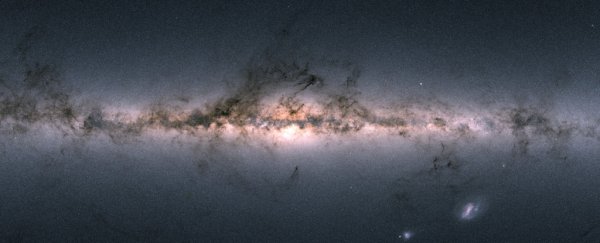When you're right in the middle of something, it's pretty hard to tell exactly how big it is. Like the Milky Way galaxy, for instance. We can't exactly go take a picture of it from the outside, so our best estimates rely on distance measurements to objects on the outskirts.
An estimate based on Gaia mapping data last year gave us a disc diameter of about 260,000 light-years, give or take. But, just as the Sun's influence extends farther than the Kuiper Belt, the gravitational influence and density of the Milky Way - its invisible dark matter halo - extends farther than the disc.
How much farther? Well, as new calculations have found, quite a bit. In a new paper submitted to the Monthly Notices of the Royal Astronomical Society and uploaded to arXiv, astrophysicist Alis Deason of Durham University in the UK and colleagues have revealed a diameter of 1.9 million light-years.
There's more to the Milky Way than the stuff we can see - the stars and gas all whirling in orbit around Sagittarius A*, the supermassive black hole at the galactic centre. We know this because the stars at the outer edges of the galactic disc are moving much faster than they should be based on the gravitational influence of detectable matter.
The additional gravitational influence giving that rotation a push is interpreted as coming from dark matter - a vast, spherical halo of the stuff that envelopes the galactic disc. But, because we can't detect dark matter directly, we have to infer its presence based on how it affects the stuff around it.
 Schematic diagram of our galaxy's dark matter halo. (Digital Universe/American Museum of Natural History)
Schematic diagram of our galaxy's dark matter halo. (Digital Universe/American Museum of Natural History)
So, that's what Deason and her international team of colleagues did.
First, they conducted high-resolution cosmological simulations of the dark matter haloes of Milky Way-mass galaxies, both in isolation and in analogues of the Local Group, a small group of galaxies about 9.8 million light-years across, to which the Milky Way belongs.
They were particularly focused on the Milky Way's proximity to M31, AKA the Andromeda galaxy, our closest large neighbour, and with which the Milky Way is due to collide in about 4.5 billion years. The two galaxies are currently about 2.5 million light-years apart - close enough to already be interacting gravitationally.
Using several different simulation programs, the team modelled the Milky Way's dark matter halo, looking at radial velocity - the orbital speed of objects moving around the galaxy at various distances - and density to try and define the edge of the dark matter halo.
These simulations all showed that, beyond the dark matter halo, the radial velocity of objects such as dwarf galaxies dropped noticeably.
They then compared this to a database of observations of dwarf galaxies around the Milky Way in the Local Group. And, just as their simulations predicted, there was a sudden drop in radial velocity. The radial distance the team calculated to this boundary was after a distance of around 292 kiloparsecs - about 950,000 light-years.
Double that for the diameter, and you get just over 1.9 million light-years.
This distance can still be refined, and should, since it wasn't the main focus of this research, but it helps place important constraints on the Milky Way, and could be used to find such boundaries for other galaxies.
"In many analyses of the Milky Way halo its outer boundary is a fundamental constraint. Often the choice is subjective, but as we have argued, it is preferable to define a physically and/or observationally motivated outer edge. Here we have linked the boundary of the underlying dark matter distribution to the observable stellar halo and the dwarf galaxy population," the researchers wrote in their paper.
"There is great hope that future data will provide a more robust and accurate measurement of the edge of the Milky Way and nearby Milky Way-mass galaxies than the one we have presented here."
The research has been submitted to the Monthly Notices of the Royal Astronomical Society and is available on arXiv.
